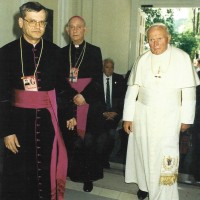The beginnings
At the beginning of the last century, the Bishop of Ljubljana, Anton Bonaventura Jeglič, realised the importance of establishing a gymnasium and institution where students would be educated as intellectuals as well as nationally-conscious Slovenes and good Christians. Part of the necessary resources were raised by the Bishop with the help of several priests, but above all the Institution was built with contributions of the common Slovene faithful.
In July 1901 Bishop Jeglič blessed the foundation stone. The first two-thirds of the institution were already finished by 1905; the last third (the left wing) was completed in 1910. After many years of effort, St. Stanislav’s Institution was the first Slovene gymnasium. On the front of the building the founder inscribed: To Christ – the Saviour of the World.
The gymnasium’s mission was the upbringing of character as well as the education of the intellect, holding to the principle that “a learned person in the realm of science can be simultaneously a nobody of character.”
In 1913 the first maturity examination (comprehensive exit exams or “A levels”) at the first Slovene gymnasium was a historical one – it was conducted in the Slovene language for the first time.
First World War
During the First World War there was an army hospital in the Institution and upper-class students were mobilised into the military. After the war the Institution carried on its mission under new circumstances and in a new state (Yugoslavia).
Second World War
On 28th April 1941 the building was taken over by German occupying forces. The students and the staff had to vacate the building within three hours. However, the process of education more or less continued in different locations in Ljubljana. The school was officially closed on 5th June 1945 and the Institution was taken over by the Yugoslav army. In May and June 1945 the building and its surroundings were used as a concentration camp from which thousands of Slovene anti-revolutionists were taken to execution. After that the Institution served as barracks for the Yugoslav army.
Modern times
In 1991, after Slovenia’s independence, the first democratically elected government returned the building to its original owner – the Archdiocese of Ljubljana. On 13th November 1992 Archbishop Dr. Alojzij Šuštar legislatively re-established St. Stanislav’s Institution for education. In its realm the following constituents have been gradually set into operation: the Gymnasium, the Student Home, the Music School, the Slovene Home, the Residence Hall, the Primary School and the Kindergarten.
Many Church dignitaries, politicians, and prominent cultural figures from Slovenia and abroad have visited St. Stanislav’s Institution since its reestablishment. On 17th May 1996 St. Stanislav’s Institution had the special honour and joy of welcoming the Holy Father, John Paul II and his escort. On this occasion the Pope blessed the School Chapel and met with some students, employees and benefactors of the Institution.
In 2013 the Diocesan Classical Gymnasium celebrated the 20th anniversary of its reestablishment as well as the 100th anniversary of the first maturity examination carried out entirely in the Slovene language.
In 2011 the fondation stone of the new building of primary school was laid. For seven years classes were held in the central building, but on 1st September 2014 it moved to the newly constructed building next to the institution. On the same day Good Shepherd Kindergarten was founded and set in operation.
Memorial Site Peace be with you at St. Stanislav’s Institution honours all victims of WWI, WWII and post war massacres. It was designed by architect Robert Dolinar in 2015 to commemorate the 100th anniversary of the beginning of WWI and 70th anniversary of the end of WWII. The memorial site consists of seven stone blocks on which the words Peace be with you (3 Jn 1,15), are engraved in the languages of those who suffered here.
The commemorative year was observed in St. Stanislav’s Institution in the academic year 2014/2015 under the motto: “I am here to love, not hate.” (Antigone, Sophocles)















